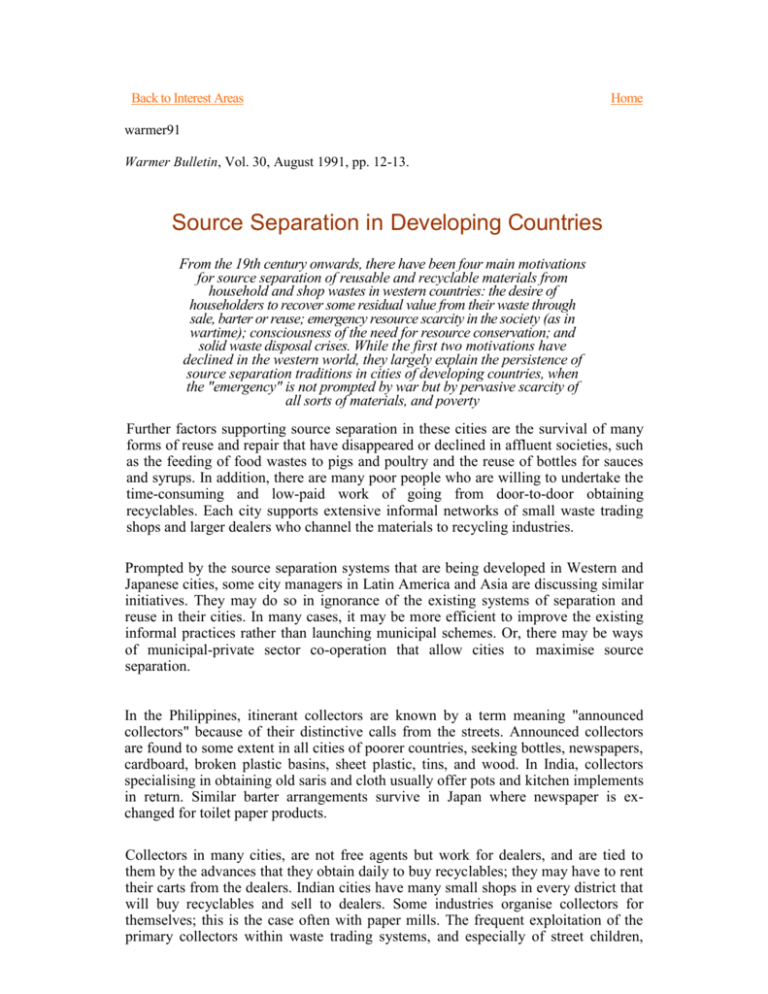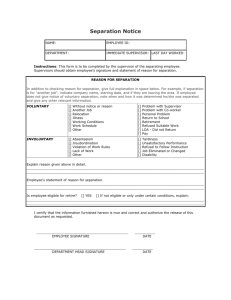Source Separation in Developing Countries.
advertisement

Back to Interest Areas Home warmer91 Warmer Bulletin, Vol. 30, August 1991, pp. 12-13. Source Separation in Developing Countries From the 19th century onwards, there have been four main motivations for source separation of reusable and recyclable materials from household and shop wastes in western countries: the desire of householders to recover some residual value from their waste through sale, barter or reuse; emergency resource scarcity in the society (as in wartime); consciousness of the need for resource conservation; and solid waste disposal crises. While the first two motivations have declined in the western world, they largely explain the persistence of source separation traditions in cities of developing countries, when the "emergency" is not prompted by war but by pervasive scarcity of all sorts of materials, and poverty Further factors supporting source separation in these cities are the survival of many forms of reuse and repair that have disappeared or declined in affluent societies, such as the feeding of food wastes to pigs and poultry and the reuse of bottles for sauces and syrups. In addition, there are many poor people who are willing to undertake the time-consuming and low-paid work of going from door-to-door obtaining recyclables. Each city supports extensive informal networks of small waste trading shops and larger dealers who channel the materials to recycling industries. Prompted by the source separation systems that are being developed in Western and Japanese cities, some city managers in Latin America and Asia are discussing similar initiatives. They may do so in ignorance of the existing systems of separation and reuse in their cities. In many cases, it may be more efficient to improve the existing informal practices rather than launching municipal schemes. Or, there may be ways of municipal-private sector co-operation that allow cities to maximise source separation. In the Philippines, itinerant collectors are known by a term meaning "announced collectors" because of their distinctive calls from the streets. Announced collectors are found to some extent in all cities of poorer countries, seeking bottles, newspapers, cardboard, broken plastic basins, sheet plastic, tins, and wood. In India, collectors specialising in obtaining old saris and cloth usually offer pots and kitchen implements in return. Similar barter arrangements survive in Japan where newspaper is exchanged for toilet paper products. Collectors in many cities, are not free agents but work for dealers, and are tied to them by the advances that they obtain daily to buy recyclables; they may have to rent their carts from the dealers. Indian cities have many small shops in every district that will buy recyclables and sell to dealers. Some industries organise collectors for themselves; this is the case often with paper mills. The frequent exploitation of the primary collectors within waste trading systems, and especially of street children, means that there are social concerns about waste recovery in developing countries that are insignificant, if existent, in richer ones. So city has attempted to investigate the amounts of resources recovered from households, shops and businesses through these means, although it is obvious from analyses of wastes received at dump sites that, in the poorer countries, almost all significant manufactured recyclables are extracted from waste streams earlier. (In China, India, Vietnam and parts of Indonesia, and similar societies, the result is that wastes at dumps readily decompose into compost without mechanical processing). In China, source separation has been officially supported since the 1950s by the system of neighbourhood collection stations, district and regional recovery companies. People are urged to bring all recyclable materials to the stations where they are bought at fixed prices. Some stations also run second-hand shops, which sell army surplus goods as well. Large cities like Beijing, Shanghai and Guangzhou used to have 400-500 neighbourhood stations but recently half or more of these have closed down. Their decline illustrates the problem of household income supplementation as a motivation when standards of living rise. Most urban families no longer find it worth their time to carry materials to the stations for a very small return. The Ministry of Commerce could have overcome this by adjusting the prices paid for recyclables, but, while incomes and general prices rose in the past decade, there was virtually no change in prices offered by the waste recovery system. Thus, even though resource scarcity still exists for industries, individual motivation to take items to the depots has eroded. Some waste recovery companies are trying to revive interest through lottery coupons that give discounts at department stores. In the past decade, the relaxation of constraints upon rural migrants taking work in cities has led to a revival of door-to-door collectors, which suggests that people are still interested in selling wastes, if they do not have to go to the stations to do so. Ironically, Chinese households have some similarity to average western ones with respect to source separation, because they lack servants. In elite and middle-class urban areas of other developing countries, it is usually the servants who have the rights to household wastes. Thus the fact that selling household wastes brings very little return may not inhibit the practice. Understanding the motivation for source separation in Bangkok or Jakarta, Rio or Buenos Aires, then requires examining the wages and lifestyles of servants in addition to those of householders. When wages for domestic help improve, even maids may lose interest in setting aside recyclables. The case of Kuala Lumpur illustrates how rapid economic improvement can eliminate the itinerant collectors, thus depriving householders of the opportunity of selling recyclables, should they wish to. During the oil boom period of the 1980s, the collectors declined dramatically in numbers, and the amounts of recyclables of all kinds reaching garbage. dumps increased; by late 1986, unemployment and a revival of waste trading brought back the collectors, and the change at the garbage dumps was noticeable. These experiences suggest that source separation based on small enterprise and private collectors can be sustained in cities of developing countries. Planning for source separation to enable maximum recycling of municipal wastes should first assess the existing practices of waste collection and sale or barter in order to decide how far these should be supported and enhanced, or possibly supplemented or replaced by municipally-organised schemes. This includes attention to issues of exploitation of street people. If itinerant collectors are on the decline, or their support is considered impractical, the next step could be to enable municipal collection crews to buy recyclables while picking up the refuse from elite areas where kerbside collection takes place. At present most crews sort out recyclables from the mixed refuse en route; this valuable work could be made cleaner and more efficient if source separation was encouraged, even mandated. In some city neighbourhoods, it may be then relatively easy to get householders to co-operate with wet/dry separation to allow safe and efficient compost making. Hence there would be a progression from the household income supplementation motivations to environmental conservation as a general goal. Since many of these cities also face severe lack of dumping space, the solid waste crisis will soon become another motivation for co-operation for source separation, at least among the educated urban residents. [Based on "Source Separation of Municipal Solid Wastes: A Framework for Comparative Analysis", by V Maclaren and C Furedy, delivered at meeting of Association of American Geographers, Toronto, April 1990.] *Christine Furedy D. Phil. Urban Studies Programme, Faculty of Arts, York University, N York, Ontario, M3J1P3 Canada August 1991






